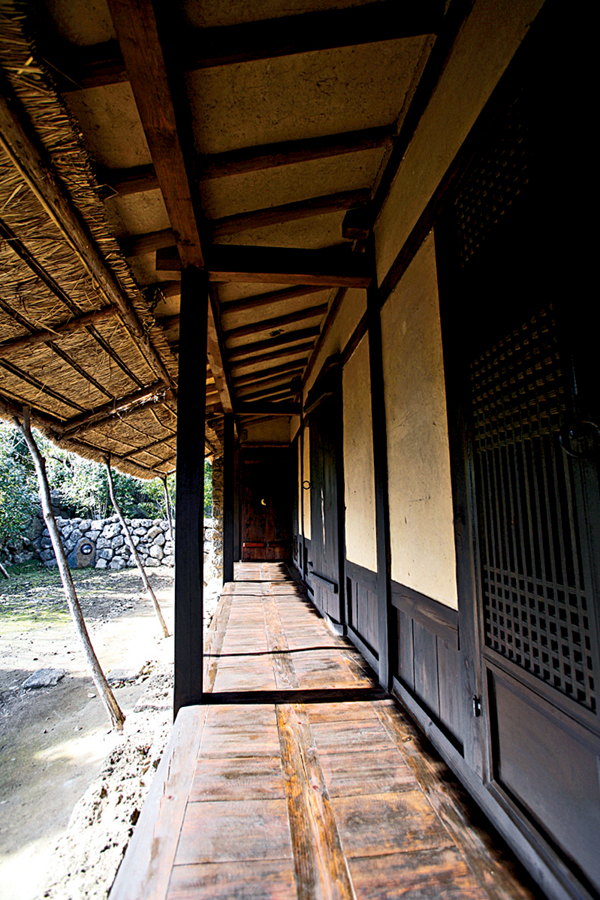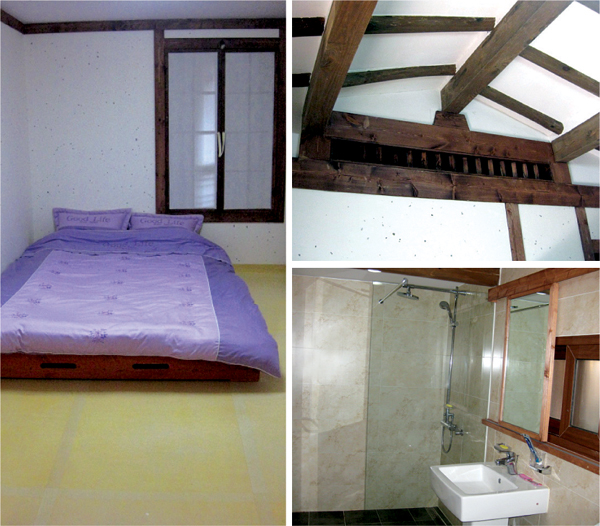
Feb. 16 (Jeju Weekly) For anyone wanting to experience what it might have been like to live in a traditional thatched Jeju house while still enjoying modern comforts, the Choga Minbak at Seongeup Folk Village is the perfect answer. Each of the six houses scattered throughout the village is completely traditional on the outside, with stone walls, wooden doors and the straw-thatched roofs, or choga, for which they are named. Step inside however, and you are greeted by a pristine interior of walls lined with hanji, or Korean traditional paper, above wooden skirting boards and with a flat-screen LCD television dominating one wall of the living area.
Situated off each side of the house we looked at were two bedrooms with comfortable beds on wooden bases and wood lattice and hanji inner doors and windows. Open these and the outer solid wood doors and there are views across the verandah and tree-filled yard to other parts of the village, where horses and pigs are tended and men can be seen tying fresh straw roofs on buildings and trimming the dangling ties.
 | ||
The modern touches continue in the kitchen, which has ceramic top cookers for heating water in the kettle supplied and a small fridge secreted behind a wooden door. The bathrooms feature a tiled shower booth with one glass wall and shower heads at various heights and other modern fixtures. There is a traditional outhouse displayed in the village but the amenities in the minbak houses are thoroughly up-to-date. Discreet digital displays on the wall of each room operate the ondol, or under-floor heating, making for a comfortable stay even in the coldest weather.
The minbak, which translates most closely as home stay but here uses the term loosely as staying with the village rather than in an individual’s home, was established in June 2009 by Seogwipo City Hall.
“Already about 800 people have stayed in it,” said Koh Sang Bum of the Seogwipo City Hall’s culture and art department. Koh, who is in charge of Seongeup Folk Village, said about 10 of those guests have been from countries outside of Korea, including Japan, China, Germany and the United States.
“In 1984,” he said, “the Central Government identified Seongeup as one of six folk villages in Korea and it has the largest population.”
The original buildings used for the minbak were very old so they were remodeled on the inside while left in their original exterior form. Most of the private houses in the village are similar, with the outside appearing as it would have generations ago while the interiors have been updated for comfort and to provide modern conveniences. The display buildings that are uninhabited are kept in the traditional style, although Koh said many had been damaged or destroyed over the years and not all the repairs and refurbishments were purely traditional. It is planned to replace those repairs with more authentic work.
 | ||
The inspiration behind the lodgings was to let people experience what life would have been like in a traditional village, Koh said. To help authenticate that experience, the village has for the past two years had a summer program where visitors could re-enact traditional village activities. These will restart in March but will continue year round from then. Although the details are being finalized now, the program is likely to include past favorites, such as brewing Omegisul and Gosorisul, two alcohols traditionally made on Jeju Island, making rice cakes and learning about the husbandry of Jeju’s famous black pigs.
Visitors are not permitted to cook inside the minbak houses because of concerns of fire safety but there are many restaurants scattered throughout the folk village and nearby. There are also many companies close by which offer horse-riding, ATV rides, go-karting and archery for guests who want to venture a little further afield. But the folk village offers much to see, experience and photograph within its gates, and Choga Minbak provides serene and comfortable lodgings from which to venture out.
Costs range from 40,000 won per couple through 80,000 won per couple depending on the house size. Bookings can be made by phone but only in Korean.
Choga Minbak
Seongeup Folk Village
Pyoseon, Seogwipo
Tel. 064-787-5560,
010-6482-1456 (Korean only)
www.songeup.net (Korean only)
How to get there:
By car: Seongeup Folk Village lies on the 97 highway between Jeju City and Pyoseon Beach and is well signposted. Once there, the information and management office can be difficult to find without already having a map, but the villagers are happy to give directions.
By bus: From Jeju City Bus Terminal, take the Jeju City to Pyoseon service (there is no number and the destination is written in Korean only). It takes about 40 minutes to reach Seongeup Folk Village.
From Seogwipo City Bus Terminal, first take the Seogwipo to Pyoseon service, and change at Pyoseon to the Pyoseon to Jeju City service.




No comments:
Post a Comment